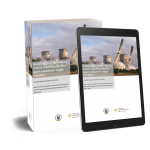In our new brief written by Christoph Nedopil, Mengdi Yue, and Ulrich Volz and published together with the Green Finance & Development Center at FISF Fudan University and the Centre for Sustainable Finance at SOAS University of London, we analyze global practices for financing early coal retirement for accelerated green energy transition. The full report can be downloaded here.
The report was supported by the UK Pact programme.
Executive Summary
Coal-fired power is recognized as a major driver of global climate change. To reduce emissions, a number of countries around the world have started phasing out coal power and agreed to stop building new coal-fired power plants at home and abroad. In addition to their climate change implications, coal-fired power plants have become uncompetitive due to the rapidly falling cost of alternative energies. Should electricity generation be locked into more expensive coal power, either the consumers or the governments (e.g., through subsidies) would need to pay for higher energy prices in order to keep the cash flows of coal-fired power plants positive.
In response, many global, regional and national initiatives have been announced to accelerate the clean transition of coal-fired power plants, especially in developing countries. These initiatives have different focuses but also support and complement each other. They also share similar aims such as mobilising private investors with public financing, improving policy setting and governance, enhancing partnership and ensuring a socially just transition, etc.
This report reviews global, regional and national initiatives for facilitating the early retirement of coal-fired power plants and draws lessons for financing a just transition and ensuring energy security. We start by providing an overview of global coal power fleets, including their current status and profitability, and then discuss existing and proposed approaches for early coal retirement, including:
- Global and regional initiatives, including Coal Asset Transition Accelerator (CATA), Accelerating Coal Transition (ACT), Energy Transition Mechanism (ETM), and EU Just Transition Mechanism;
- National initiatives, e.g., in Indonesia, Chile, South Africa, Germany, the US;
- Other proposals or approaches by think tanks and academia.
As financing is a key factor for facilitating coal retirement, we discuss globally applied and proposed financing options, including ratepayer-backed bond securitization, asset portfolio securitization, carbon retirement portfolios, and carbon avoidance bonuses.
From existing experience, we summarise several factors that should be considered when preparing for early coal retirement:
- Political buy-in: as current coal retirement initiatives are driven by the public sector, an established policy environment and credible governance are almost always prerequisites for reducing uncertainty for investors and operators, securing multilateral concessional financing and mobilising private capital;
- Cooperation with operators: for the retirement of coal assets, either by buying them out directly or repurposing them for renewable energy projects, engagement with operators (state-owned companies or private investors depending on different cases) of coal-fired power plants is critical for the successful retirement of coal-fired power plants;
- Devising a just transition plan for affected employees and communities: to cushion adverse social impacts and to provide new opportunities to employees of to-be-retired coal-fired power plants and affected communities, a just transition plan needs to be made years before the actual transition is implemented;
- Finding the right financing options: financing for early coal retirement can take various forms, e.g., refinancing, securitization, investment portfolios, carbon avoidance bonuses. These options could be applicable in different countries and situations: commercial options might be more attractive to older assets in developed markets, while financing options provided by multilateral or national development banks are more accessible to developing countries for early feasibility studies, providing incentives to operators of coal plants and supporting affected employees and communities;
- Electricity and grid planning: grid planning, especially in developing countries with limited power accessibility, is needed to compensate for any intermittences of green energies or long distances between the electricity source and demand in cities;
- Legal and institutional planning: both the set-up of an official framework and the implementation and supervision during coal plant phase-out need legal and institutional planning in advance.
As China tightens regulations for coal plants at home and commits to stopping building new coal-fired power plants abroad, we offer policy recommendations for Chinese stakeholders engaged in overseas coal-fired power plants, for example in the Belt and Road Initiative (BRI) on the early retirement of coal assets:
- Understand the economics: Evaluate the net present value (NPV) of existing Chinese-backed overseas coal-fired power plants in comparison to the NPV of alternative new energy installations (including relevant grid extensions and power storage facilities) on an asset level for select pilot countries. The pilot countries should be a country with relevant Chinese engagement in coal-fired power plants and a stated interest in reducing the share of fossil fuel energy in the power mix (e.g., Pakistan, Indonesia, Vietnam). In the calculations, relevant financing costs, as well as various scenarios for shadow carbon prices, fuel prices, price decreases in solar/wind energy and timeframes (e.g., retirement in 2025, 2030, 2035) should be included. Furthermore, evaluate the economics including electricity prices: alternative sources of electricity that can provide lower-cost electricity to consumers, including industrial consumers, could improve the overall economics of replacing the coal-fired power plant.
- Evaluate Chinese and host country policy goals: Chinese policymakers have emphasized the relevance of green development at home and abroad, the relevance of the Paris Agreement to limit global warming domestically and for BRI development, and explicitly announced support for green energy development in BRI countries, in African countries and globally. With fossil-fueled power recognized as a non-Paris-aligned energy source, Chinese investors, developers, and fossil fuel owners can evaluate how to support publicly stated Chinese policy goals. At the same time, BRI host countries have explicitly stated goals to de-carbonize their economies, not least through their nationally-determined contributions (NDCs). Accordingly, supporting BRI countries to achieve these goals could take the form of supporting early coal retirement.
- Engage with pilot countries: Engage pilot countries on a political level to discuss technical, legal, political, and financial cooperation on early coal-retirement of identified potential assets. This should help understand hidden costs and opportunities, as well as other legal and social risks of early coal retirement while ensuring political interest and support in the host country. Engage with local society to understand requirements and needs to reduce coal reliance and possibilities to reduce electricity costs. This could also help local policymakers in their decisions and provide relevant policy frameworks for early retirement.
- Develop and evaluate green energy scenarios with the pilot country: Understand specific requirements of energy planning in the pilot country and simulate supply and demand in various scenarios of early coal retirement. Particularly as networks might not be available for supporting intermittent electricity supply or as energy storage might not be sufficiently developed, this energy planning should take a phased approach.
- Engage with existing asset owners: Evaluate requirements and negotiation strategies with asset owners on early retirement. As each country and the coal-fired power plant might be owned and operated under different governance structures, competent negotiation partners could also provide existing asset owners relevant participation in new energy parks to improve willingness to engage.
- Financing mechanism: Depending on the NPV calculations (e.g., NPV of existing coal-fired power plants is much/little lower/higher than NPV of alternative energy investment), evaluate different financing mechanisms that can include both domestic and international, as well as multilateral sources of finance. As international commercial and development financial institutions are interested in supporting the expansion of green energy in their portfolios, more financing options for green energy investments, including financing retirement are available, some of which were mentioned above (e.g., ADB ETM):
- NPV of alternative energy is higher: evaluate commercial financing solutions;
- NPV of alternative energy is slightly lower: evaluate blended finance solutions;
- NPV of alternative energy is much lower: no action or secure philanthropic/public funding.
- Support engagement with local communities and employers: although this step would also be the responsibility of the local government and asset owner, competent Chinese partners could provide guidance and share experience in job transition. For example, Chinese partners can provide relevant capacity building and job opportunities in energy transition by investing in local manufacturing of relevant equipment.
Despite early trials, early coal retirement is highly complex, and often requires evaluation of economics, legal and social considerations on the asset level to find specific solutions for each coal-fired power plant. In this regard, however, financing coal retirement is just as complex as financing any new coal project that requires project-specific evaluations.








Comments are closed.